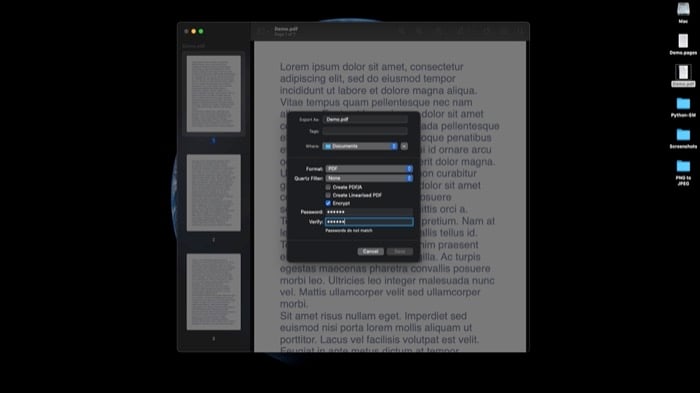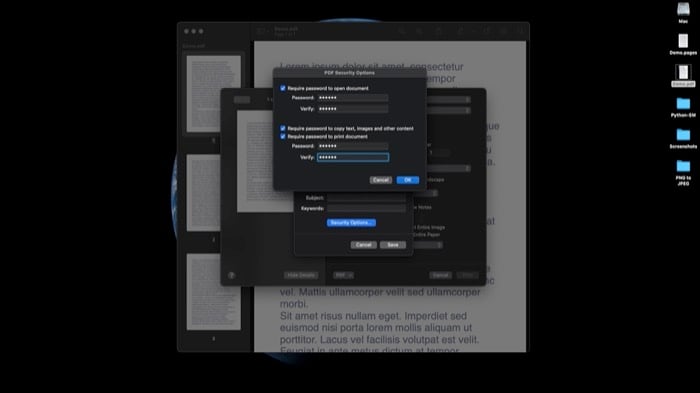In the current situation across the world, where a large number of people are working from home, PDFs are the obvious choice to share documents conveniently across the internet. However, since these PDFs go through the internet, there are some risks and concerns attached to their security. Mostly because when you share an unencrypted, open PDF, anyone can access it freely. Not just that, if permissions aren’t restricted, anyone can make changes to the PDF and take prints. One of the best practices to avoid running into such problems is to password-protect (encrypt) your PDFs before sending them across. And whenever possible, restricting permissions to prevent what one can do with your PDFs if they happen to unlock (decrypt) it. To help you in the process, we have put together a guide on how to password-protect a PDF on your Mac. So you can secure your PDFs before sharing them. In case you are a Windows user, we have a dedicated guide on how to password protect PDFs on Windows.
How to Password Protect PDFs on Mac
If you are using macOS, you have three native ways to password-protect a PDF. These methods involve using two native apps — Preview and Pages, and one native functionality — Print.
Method I – Password Protect PDF using Preview
Preview is a built-in app on macOS, and you can use it to password protect your existing PDF file. Steps:
Open Preview and select File from the menu.
Next, browse through your files to find the one want to encrypt and click Open.
Once the file (PDF) is loaded, go to File > Export.
On the next screen, click on the drop-down menu beside Format and choose PDF.
Now, check the checkbox next to Encrypt and add your password twice. Make sure you use a strong password.
Finally, click Save to apply the changes.
Method II – Password Protect PDF using Pages
While the Preview method works absolutely fine to password-protect PDFs, for times when you are working on a document and want to convert it into a PDF and encrypt it, using Pages saves you a few steps. Steps:
If you are working on a document in Pages, save it and go to File > Export to and select PDF.
In the Export Your Document window, choose the PDF tab and check the checkbox next to Require password to open.
Now, enter your password twice and add a password hint — to refer to if you forget the password.
Click on Next, and on the next screen, choose a location to save the file, and click Export.
Method III – Password Protect a PDF using Print
Lastly, in addition to using Preview and Pages, you can also use the Print functionality on macOS to password-protect PDFs on your Mac. One of the advantages of going this route is that you also get to manage access permissions for your PDFs. That way, you can limit others from copying content, making changes, and printing the document. Steps:
Open the PDF you want to encrypt in Preview. Alternatively, if it is a Pages (.pages) file, open it in Pages.
Go to File and select Print. You can also use the command + p shortcut for quick access.
In the Print window, click on the drop-down button for PDF and select Save as PDF from there.
Now, in the next window, click on Security options.
On the PDF Security Options window, check the checkbox next to Require password to open document and add your password. In addition, if you wish to limit access permissions so that others can’t make changes, copy the content, or print the document, you can check the checkboxes next to each of the two options and add a password. [This goes without saying, but make sure the two passwords are different.]
Hit OK, and select Save. All of the above-mentioned native methods help you encrypt (password-protect) a PDF on Mac, with the Page method going as far as to offer you the ability to set access restrictions. For most users, these methods should suffice the needs. However, if you want more control over protecting your PDFs and increased security protection, using a third-party app is the way to go. You see, all the native methods we’ve listed in this guide secure the PDF with the AES-128 bit encryption. While AES-128 is a safe standard, it uses fewer rounds than AES-256, which is what makes it a less secure implementation than the AES-256 encryption. But that is not to say that AES-128 is incompetent either since it can manage to keep your PDFs protected for most general use-cases. However, if you still plan on protecting your PDFs with AES-256 bit encryption and want more control over PDF access permissions, you need third-party apps/software. Some of the PDF software you can use on Mac include Adobe Acrobat X, Wondershare PDFelement, and Gorilla PDF.
Moreover, the password you set up to encrypt file only protects it (to a degree) from unauthorized access, and so, if anyone uses a decrypter tool to unlock your PDF or gets access to your password, they can then make changes and print the PDF — if there are no restrictions in place. To avoid this, what you can do is set a permissions password, in addition to the unlocking password, for your sensitive PDF files. So, even if someone manages to open your PDF, they can’t modify or print its content. Using any of the methods mentioned above, you should be able to password-protect PDFs on Mac easily. In our opinion, though, using the Print method is the best way to secure your PDF from both unauthorized access and unauthorized editing and printing. Alternatively, you can also check out the third-party apps we’ve mentioned to get more control over access permissions and restrict access to your PDFs. That said, for most users, with average use-case, the default Preview and Pages method output should also be just fine. Lastly, if you need to remove password-protection (encryption) from a PDF, all you have to do is follow steps 1-4 from method 1, and uncheck the checkbox next to Encrypt, and hit Save.














